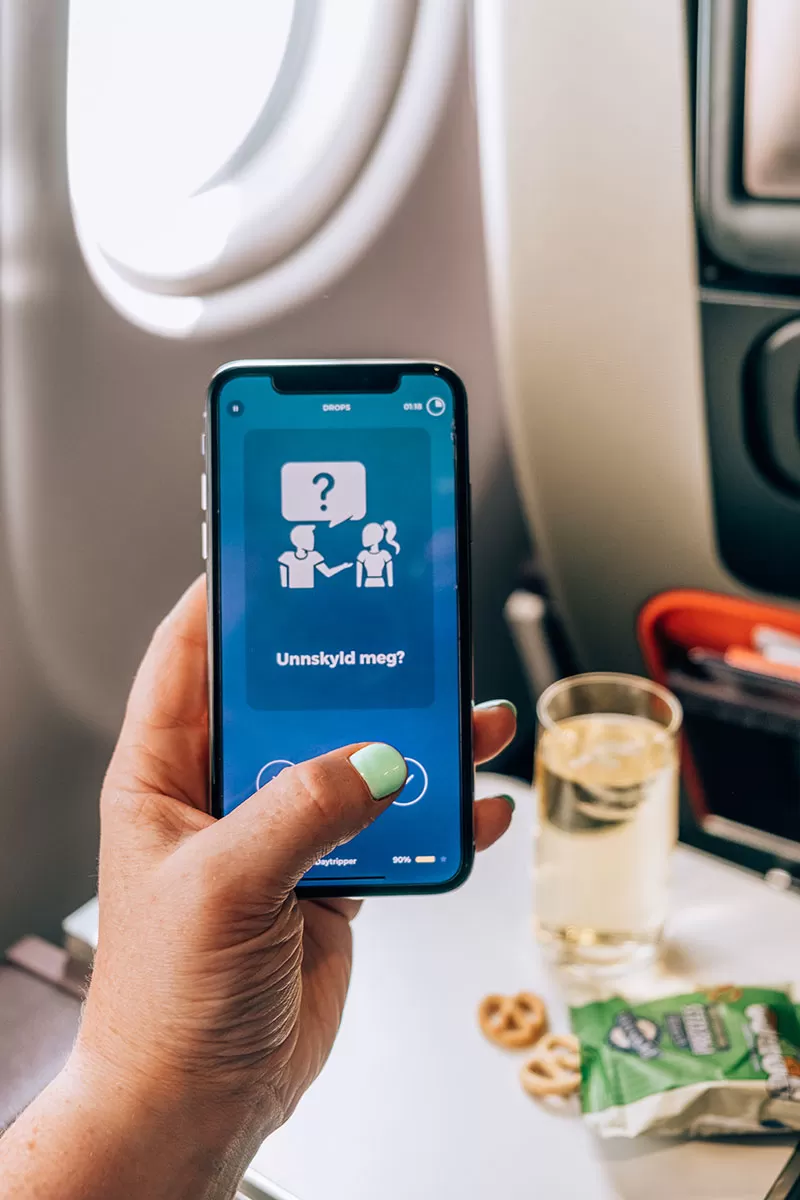eeHave you had a terrible experience learning a foreign language then failed? Then you need this fail-proof language learning strategy and daily routine to keep you on track.
For those who only speak one language, learning a new one can seem as alien as trying to start a band or take up professional diving. Many people have had horrible experiences when trying to learn foreign languages and subsequently failed too many times to count. If you’re one of those people, you’ve probably struggled with language learning because you haven’t seamlessly integrated it into your everyday life. No matter how busy you are to learn languages, you can skyrocket your progress. Here are 13 ways to can successfully integrate language learning into your everyday life.
The REAL Reason Why So Many People Fail to Achieve Foreign Language Fluency
You could make an endless list of reasons why people fail to learn a new language: bad experiences, it’s too hard, no time, etc. That’s looking at the symptoms, not the underlying cause. The real problem is that people forget that learning a language is a natural process.
Instead, many people tend to treat it like a subject in school or a chore. They spend most of the day trying to figure out how to cram a short lesson into their very busy schedules. Believe me, I’ve been there. But like anything forced into our lives, without an overbearing amount of pressure driving us to make it happen, it’s hard to maintain our efforts.
If you want to learn a foreign language, you have to approach it differently. The whole process needs to feel natural. This will help you chip away at any language without effort, even if you have a full-time job. To make it feel natural, you’ll need to follow these necessary steps to seamlessly integrate language learning into your everyday life.
1. Set SMART Goals
It’s easy to lose track of your goals when learning anything, including languages. Expectations, experience, and life, in general, can make us forget why we started learning languages in the first place. If you want to seamlessly integrate languages into your life, then your first step is to start with S.M.A.R.T. goals.
S.M.A.R.T. goals are beneficial because they help you clearly picture what you want to accomplish while providing a detailed roadmap for how to make your language-learning goals come true. Here’s what they look like:
- Specific: Avoid being generic with your language learning goals. Your SMART goals need to be as detailed as possible.
- Measurable: You want a way to gauge your progress and measure success. There should be some objective way to evaluate whether or not you’ve achieved your goal.
- Achievable: Break down large goals into small, achievable parts that you can tackle.
- Relevant: Each goal you establish should connect to a larger, overarching goal. Your study efforts and activities should help guide you closer to that goal.
- Time-Bound: Parkinson’s Law states that “work expands so as to fill the time which is available for its completion”. You need to have a deadline for any goal you create. Otherwise, you’ll find that your efforts sprawl and progress falls short.
What Does An Example of S.M.A.R.T. a Goal look like?
By filtering your general goal through the S.M.A.R.T. process, you’ll clearly define your language learning goals. For example, “I want to learn French,” turns into, “I want to speak French at an A2 level within 3 months. I’ll do this by focusing on common phrases in French for 30 minutes every day, 5 days a week with my favourite language learning program.”
Using S.M.A.R.T. goals changes your general goal into a specific strategy that you can immediately start working towards. It helps keep your efforts focused along the way.
Potential Downsides to S.M.A.R.T. Goals
S.M.A.R.T. goals initially require effort to set up. There’s also the risk of failure. That’s why you want to be realistic when you set your goals. Language learning is a gradual process. Setting your goals too high may result in a failure to notice success, negatively impacting your esteem when you should be celebrating your accomplishments.
2. Schedule Language Learning
Your daily willpower is finite. Every time you make a decision, it drains a little bit of that willpower. This makes it harder for you to follow through on decisions later on in the day. In fact, one study showed that judges often denied prisoners parole at hearings in the afternoon. It wasn’t a post-lunch funk that left them drained, unwilling to grant clemency. It was the fact that their morning hearings had drained most of their willpower.
When it comes to learning a new language, you need a schedule. There’s a strong correlation between success and routine. However, when you sit down to schedule in learning a new language, it doesn’t need to be a long-drawn-out process. Focus on consistency.
You’ll want to know when you’ll study your target language each day. Keep in mind that everyone has high points for productivity. If you do your best work in the morning, pencil in 30 minutes a day, 5 days a week to work towards fluency in the morning while you sip on a coffee. If you’re a night owl, then schedule your lessons later on in the day. If you prefer to stick to science, studies show that 10:00 am to 2:00 p.m. and 4:00 p.m. to 10:00 p.m are the best times to learn something new.
You also want to be realistic. While it’s admirable to want to study for several hours every single day, keep in mind that life throws curve balls at us all the time. Focus on 5 days each week. Give yourself a 2-day buffer. If you get in more time to practice, that’s just a bonus.
3. Be Consistent
 Studies show that on average, people take 66 days to form a new habit. If you’re looking to seamlessly integrate learning a new language into your life, you’ll need to work hard to survive those first days.
Studies show that on average, people take 66 days to form a new habit. If you’re looking to seamlessly integrate learning a new language into your life, you’ll need to work hard to survive those first days.
People often fail to achieve New Years Resolutions for numerous reasons, but failing to be consistent is the main one. That’s why gyms are packed each year until the middle of February. People slowly stop going until they stop altogether.
At first, you need to take it one day at a time. Focus on completing your daily lesson. Then the next one. Then the next… When you miss a lesson, you’ll need to squeeze it in where you can. If you miss a week or even two, don’t worry. Dust yourself off and keep at it.
If you keep trying, you’ll eventually make it a habit. Soon enough, the days when you miss your language-learning lessons will actually bother you. That’s when you know it’s become a habit.
One thing to keep in mind, though, is not to do too much, too fast. Humans aren’t great at accepting change. Habits are hard to form. Too many rapid changes can shock your system. So, if you’re looking to remain consistent with your language-learning efforts, focus on slow, incremental changes. Then ramp up your efforts over time.
4. Develop a Growth Mindset
Made famous by Dr. Carol Dweck, a growth mindset describes the attitude a person has when they approach any task or challenge. Having the right mindset can make a huge difference when setting out on your language-learning journey.
- Fixed Mindset: The belief that you cannot change or grow. Challenge reaffirms that belief, leaving the learner stuck in a cycle of self-fulfilling prophecies where failure becomes a well-established norm.
- Growth Mindset: When you believe you can grow and get better, you work harder to make that come true. As a result, you achieve your goals. Challenge is a reminder that no path is easy. Instead, it gives you time to reflect on mistakes before pushing forward.
Both approaches are mindsets, meaning they’re learned behaviours. While you may have a fixed mindset, you can work to create a growth mindset. With language-learning, this comes from understanding that anyone can learn a language. It just takes patience, consistency, and the right approach to achieve fluency.
If you fail to reach your goals, take a step back, look at what you’re doing, try another strategy, and keep moving forward. Remember that having a growth mindset isn’t about focusing on failure. It’s about understanding that hard work and effort does pay off, you just need the right approach.
5. Find the Right Motivations
Motivation is crucial if you want to successfully learn a new language. There are many different ways to stay motivated while learning a new language. But the type of motivation you’re after matters just as much as how you go about staying motivated if you want to make language learning feel like a natural part of your life. There are two types of motivation:
- Extrinsic Motivation: Reward-driven behaviour. This is when you complete a task to earn money, status, objects, etc. (Working to get paid, for instance).
- Intrinsic Motivation: Completing tasks for their own sake. This is when you do something simply because you enjoy it. (Traveling, for instance).
If you’re looking to seamlessly integrate language learning into your life, then you need intrinsic motivation. Why? Because learning a new language takes time. Even the easiest languages take around 600 hours of study to reach fluency. At a minimum of 30 minutes each day, 5 days a week, you’re looking at just under 4.5 years to reach fluency in a foreign language.
That’s a long time.
Granted, the program you choose and the effort you put in will play a huge role in whether or not you can drastically cut that time down. But the process will still be challenging over time.
There will be moments when you feel like you keep forgetting what you just learned. Other times, you’ll feel like you’re not making any progress, and things don’t seem to stick. In those moments, any outside reward might not seem worth it. Instead, it can force you to feel like it’s more work than it’s actually worth. Once you get that feeling, it becomes harder and harder to stick with it.
The key to seamlessly integrating language learning into your everyday life is to make the process feel natural. The best way to do that is to make your desire to speak fluently come from within. Learning a language because you genuinely want to learn it will make those rough patches much easier. As a result, you’ll shrug them off and keep moving forward.
Related: 25 Tips for Procrastinators: How to Stay Motivated to Learn a Language
6. Nurture Your Independent Learner
An independent learner is someone who takes responsibility for their own learning. While a dependent learner will blame language-learning programs, the teacher, or the language itself, the independent learner will analyse how they’re approaching the content and adjust. They’ll understand that the responsibility falls on them.
Failure isn’t a necessary failure for independent learners. They acknowledge that a lack of progress most likely comes from poor strategies and weak efforts. As a result, they reflect on their learning processes, adjusting their tactics, and try again to reach their goals.
Independent learners also engage with the content. They don’t passively expose themselves to knowledge. Instead, they play around with new information, take it apart, and test it. Seamlessly making language learning a part of your life means having a genuine curiosity for the language you’re trying to learn.
7. Understand That Forgetting Is Part of the Process
We can only learn a new language so fast because our brains get in the way. To create new memories, we have to build new neural pathways in our brains to store new information. The problem is that our brains like to filter out the details we don’t use. It has no real way to categorise between the stimuli you casually absorb on a daily basis and vital information.
As a result, you will naturally forget what you learn as you try to reach fluency in a foreign language. But this shouldn’t upset you. It’s all part of the process. Every lesson you review, each language practice session you partake in is another attempt to root that knowledge a little deeper in your brain. Understanding that and revisiting previous lessons to brush up on weaker knowledge will help you retain the information longer.
8. Choose Effective Language-Learning Tools
 Once you’ve prepared your mind to learn a new language, you need the right tools. Imagine moving your house one box at a time. You’ll be far more exhausted than you would be using a dolly, right? At the end of the day, you need the right tools. Luckily, there’s a lot of them out there.
Once you’ve prepared your mind to learn a new language, you need the right tools. Imagine moving your house one box at a time. You’ll be far more exhausted than you would be using a dolly, right? At the end of the day, you need the right tools. Luckily, there’s a lot of them out there.
So, how do you choose?
When trying to find the best language learning tools, comprehensible input is what matters most. Coined by renowned linguist, Stephen Krashen in his Theory of Secondary Language Acquisition, Comprehensible Input is essential information just outside your ability to fully understand with ease. It shouldn’t be so easy that it’s boring, nor should it be too hard, so you get frustrated and give up. It’s a Language-Learning Goldilocks Zone if you will.
When looking for any language learning materials, you’ll want to keep the difficulty slightly above your ability to comprehend. You should have fun. Pick topics that are interesting. If you like Netflix, DisneyPlus, or YouTube, you’ll find plenty of materials available there. Language learning apps make it easy to test yourself on the run and there are plenty of other native materials you can review and workbooks you can find. Here are 44 best movies on Disney Plus for learning languages
Related: 22 Genius Tips for Language Learning with Netflix [The Only Guide You Need]
There really is no ONE PERFECT WAY to learn a language. But as long you go after comprehensible input and focus on what you’re interested in, you’ll be fine.
Keep in mind that translation, memorisation, drilling, and focusing too heavily on grammar are not effective nor are they natural ways to learn a language. Think about it. How many times have you seen a toddler crack open a grammar workbook? If you find yourself focusing on these tactics, try switching to a different platform and comparing results.
9. Embrace Your Learning Environment
It takes 23 minutes to refocus after a distraction. Whatever your strategy is for learning a language, at some point, you’ll have to sit down and really focus. That means closing out distractions like social media and texting to learn your target language.
Learning on the bus or while waiting for your doctor’s appointment is a great way to fill in gaps throughout the day, but to see real progress, you’ll need uninterrupted time to learn. About 30 minutes a day for 5 days a week is the minimum study time you’ll want to put into achieving fluency in any target language. If it takes 30 minutes to refocus after a distraction, you really cannot afford to be interrupted during that time. It’ll sabotage your efforts.
Some people can feel uneasy about this. It can be eerie at first. But if you’re taking all the steps so far to prepare yourself for language learning, spending at least 30 minutes with your target language a day will feel like the most natural thing in the world. After a while, you’ll crave it.
10. Find Someone You Can Talk To
Languages are tools for communication. You learn a new language so you can speak to other people. So, it’s a good idea to find people that you can speak to in your target language. The earlier you start, the better. That way you can get over any anxiety about speaking in a foreign language as soon as possible.
This isn’t always easy if you don’t have relatives or friends that speak the language. If that’s the case, then here are a few strategies:
- You can check out local neighbourhoods that have a population of native speakers in your target language.
- Hire a teacher, tutor, or language coach to have 1:1 sessions with you.
- Use language apps and services like Tandem, italki, or HelloTalk that lets you communicate with other native speakers.
- Visit local restaurants or businesses in your target language and try conversing with the staff in your target language.
Going out and finding people you can regularly talk to using your target language will help make the time you spend learning it feel like a natural part of your life.
To supplement my own language learning I personally use italki multiple times every week. This is where I get 1-to-1 support and speaking practice with a qualified teacher or community tutor. Read my full italki review here and book your first italki lesson here.
11. Gauge Progress and Reward Yourself
Extrinsic motivation is critical to language learning success, but that doesn’t mean you should avoid awards altogether. If you know anything about Pavlov’s dogs, positive reinforcement can go a long way. Sometimes having a language-learning reward on the horizon, like a fancy dinner at a restaurant where you have to speak the language or a language holiday can really help motivate you when you’re simply not in the mood to learn.
Gauging progress is key to deciding when you’re ready for a reward. You don’t need to track your progress every day. Some days will be better than others. But over time, you’ll have a better understanding of how close you are to achieving your S.M.A.R.T. goals. Once you reach them, take time to reward yourself. You’ve earned it.
12. Be Prepared for the Intermediate Plateau
At some point in your language learning journey, you’ll start to plateau. In fact, there will be little plateaus throughout the process, where you feel like you’re making limited progress. But one day, you’ll arrive at the intermediate plateau. This is where you put more and more hours into your lessons but struggle to push further in your abilities (usually around B2, according to the CEFR).
Once that happens, you’ll need to move past the apps and workbooks and focus on native materials. Native materials are the resources native speakers use in their everyday life.
If you’re just starting out on your language learning journey, then the intermediate plateau is still a ways off in the distance. But knowing it’s there and that learning plateaus are natural will help you be more prepared during your journey to fluency.
13. Be Present – Active vs. Passive Learning
If you’ve ever sat in a boring language class while the teacher drones on and on about something you’re not interested in, then you know EXACTLY what being a passive learner is. For language learning to truly fit seamlessly into your everyday life, you need to be an active learner.
Active learners care about and are involved in what they’re learning. Just like independent learners take responsibility for their learning, active learners take responsibility for learning. As an active learner, you will take advantage of every minute you spend with your language. You’ll enjoy these opportunities because you’ll see them as more chances for you to grow. You’ll be excited about the chance to learn more.
Language Learning Should Feel Natural
At the end of the day, for language learning to slip seamlessly into your daily life, it needs to feel natural. But getting to that point takes a bit of prep work. You’ll have to train your mind to embrace language learning for what it is: an experience that will add immeasurable value to your life. You’ll have to build your mindset around that idea to make lasting progress. But as long as you can stay consistent and positive about your language learning lessons, reaching fluency will soon feel like a normal part of your everyday life. For more tips, check out my 3-step method for learning languages like crazy, even if you have a crazy life.
Like it? Pin it for later!

Want to know more about learning languages? Start here!
- How to Learn Languages Like Crazy, Even If You Have a Crazy Life [3-Step Method]
- How to Get Fluent: 9 Reasons You’re Not Fluent…YET! [& What To Do Instead]
- 10 Proven Memory Hacks: How to Remember New Vocabulary Faster
- 18 Unexpected Advantages & Health Benefits of Learning A Foreign Language
- What Type of Language Learner Are You? Your 4-Step Personalised Learning Plan
- 6 Language Learning Tips: How to Learn a Language from Home
- 44 Best Movies on Disney Plus for Learning Languages
- 20 Top Language Learning Resources You Should Use in 2020
- 7 Reasons Why You Should Go on a Language Holiday
- 10 Pro Tips: How to Learn a Language with a Full-Time Job
- Essential Travel Phrases: How to be Travel Fluent in 10 Simple Steps
- How to Learn Your First Foreign Language in 8 Simple Steps: A Beginner’s Guide
- 11 Life-Changing Reasons Why You Should Learn a Language
- 23 Cool Gift for Language Learners They Will Actually Use and Love
- 42 beautiful Inspirational Quotes for Language Learners
- Language learning tips: 11 Polyglots Reveal The Secrets of Their Success
- Top 10 Best Ways to Learn a Language Better and Faster
- Language Learning Tips for Anyone Who’s Ever Doubted Themselves
- Free Travel Phrase Guides
- How a ‘Potato’ improved my French Pronunciation
- How Many Languages are there in the world?
- Hilarious Idiomatic Expressions that Will Brighten Your Day
- How to Learn Italian Before Your Trip
- How to Master Common Italian Phrases for Travel (Like a Local!)
- Mondly Review: 10 Ways Mondly Drastically Improved My Language Learning
- 78 FREE Dictionaries to Learn a Language Fast [Free eBook Download]
- 22 KEY Travel Phrases That Will Transform Your Travels [Free Guide]
Over to you!
How do you integrate language learning into your daily life?
Let me know using the comments section below or join me on social media to start a conversation.
Thanks for reading and I hope you enjoyed this post.
Like what you see? Subscribe using the form below to have all of my posts delivered directly to your email.


1 comment
Fantastic article, Michele! I’m about to jump back into my Spanish study but one of the things I’ve been struggling with is how to set SMART language goals. Your French example was perfect so that’s how I’ve set my Spanish goal this time! :-)